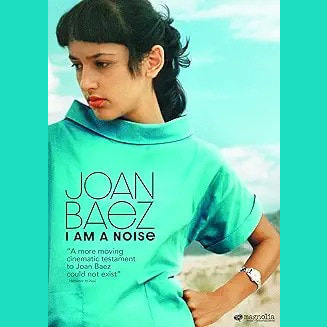|
The Breadcrumbs Widget will appear here on the live site.
1/20/2024 Joan Baez (from I Am A NoiseJoan Baez (from I Am A Noise available through Magnolia Pictures) (by Lee Zimmerman)
There’s no denying the fact that Joan Baez is the probably the most successful protest singer of the modern era. Her seminal career found her marching with Dr. Martin Luther King, crusading for civil rights and against the Vietnam War, often side by side with her compadre and compatriot (and lover), the young Bob Dylan. At age 79, she remains resolute, determined not to tour in the future because the expectations remain too high, though still committed to making music if and when she chooses. I Am A Noise paints a decisive picture of Joan Baez, who’s still in fine voice and gifted in relaying songs that are both tender and touching. The documentary offers a behind-the-scene look at a life well lived and yet frequently troubled, beginning with a manuscript written by the 13-year-old Joanie tellingly titled “What I Believe”. However, it’s the home movies of family gatherings, road trips, and communal gatherings that are especially telling, in that they capture a family fully aware of the suffering of those less fortunate, though seemingly — and deceptively — both content and contemplative. Growing up under the shadow of prejudice due to her Mexican heritage, Baez suffered from angst and anxiety throughout her life, although the source of her discomfort was never wholly defined. As a result, she entered therapy at an early age. Still, she notes that she had a social consciousness from early on, a feeling that affected her well before she ever picked up a guitar. ‘No matter how hard we try to stick to the exact story, we come out looking awfully clean compared to what is exactly right’ Baez admits, before later allowing, ‘I don’t think that anybody that is young and gets famous has any idea it will every end’. Nevertheless, it obviously served her well, particularly given her present relationship with her musician son Gabe, an active participant in her concert career. And indeed, while some may still think of her as the wayward minstrel of her youth, a portrait brought to bear in old black and white performance films, her music is as exacting and engaging as ever. Those early songs reflect the influence of archaic English folk ballads, but the extensive adulation reaped on her both by audiences, critics and the media clearly served her well. After her appearance at the Newport Folk Festival, her fame exploded practically overnight. Asked by a a bystander if she was getting writer’s cramp from signing so many autographs, she casually confides that an inflated ego would likely be the most obvious result. Baez’s sister, singer Mimi Farina, married to singer/songwriter Richard Farina, admits that early on she felt she lived in the shadow of her more famous sister. It’s evident that those feelings lingered on for quite some time. So too, when Richard Farina died in a motorcycle accident at an early age, it scarred the psyches of both of singing siblings. Still, Baez persisted. ‘Everybody, no matter how much they like to pretend, likes the thought of fame’ Baez concedes, even though she claimed at the time that she didn’t necessarily consider herself famous. On the other hand, she makes it clear that she also embraced it. ‘Being famous at a very early age, I don’t know what my life would have been otherwise’ she admits. Executive Producer Patti Smith was likely able to relate, given her own career that frequently resulted in a whirlwind of her own doing. Likewise, producer Greg Sarris manages to capture an honest and intimate portrait of an artist caught between chaos and contemplation. An ongoing affair with another young woman named Kimmie leads into film footage of Dr. King and the March on Washington, and her subsequent relationship with Dylan, who she originally met at Gerdes Folk City, the birthplace of New York’s folk music renaissance. Thinking he looked rather ramshackle at first, she quickly became enamored with him and the video of the two together captures a playful period of carefree collaboration which found the partnership morphing from the professional to the personal. Clearly, both singers were enthused and inspired. ‘When I stepped into the Civil Rights movement, I kinda stayed there… I knew I belonged there’ Baez says in retrospect. It’s clear even now that she remains deeply affected by the entire experience. Many of Joan Baez’s recollections were captured on audio tapes sent to her parents early on, all of which are still intact and an intrinsic part of the film’s spoken soundtrack. It makes the documentary all the more affecting, and her connection with the audience is especially emotional for all involved. Indeed, the interactions captured with her admirers leaves a series of lingering impressions. So too, the relationship with Dylan is thoroughly documented, but it’s clear that the chasm created by his increasing fame broke her heart. ‘It was total demoralization’ she says. She goes on to describe their shared experience during his mid ‘60s English tour as ‘total hell’. Baez then took herself to France, and while she found it exciting at first, it became a rollercoaster ride that deepened her depression. Even now she seems caught up in conflict and contradiction. Her marriage to activist David Harris helped elevate her emotions, at least temporarily, but his arrest for anti-war activities and their subsequent separation created another challenge, especially considering the fact that she was pregnant with the couple’s first child. Nevertheless, she took her responsibilities as a wife and mother seriously, but she says of Harris ‘he was too young’ before adding, ‘And I was too crazy’. Nowadays, Joan Baez is doing her best to cope with her current lifestyle, one that still includes making music, doing occasional live performances and living up to her own legendary stature. The film paints a portrait of a solitary soul, not by choice but perhaps, due to destiny. It’s both personal and poignant, drawn from a conflict between career and companionship. That’s the conclusion affirmed by her son Gabe, who insists her main mission was to save the world. Naturally then, she clearly seems torn between two extremes. Still, her life and career has clearly been filled with memorable moments, spawned from the success of her career-changing album, Diamonds and Rust, her participation in Dylan’s Rolling Thunder Revue, an awkward appearance at the benefit at the 1986 Amnesty International concert and, by her own admission, her frequent use of quaaludes. ‘There was a kernel that had to be popped or cracked or whatever’ she reflects. In that regard, the voice of her psychiatrist offers a soothing salve of a narrative throughout. Yet it’s Baez herself who’s clearly committed to reconciling her tangled emotions, feelings that were partly the result of a father who preyed on his daughters through clear sexual suggestion. Recordings of her poppa talking to a therapist find him apparently unaware of his transgressions, and yet it leads to a tattered trajectory that muddles the memories even further. Seeing her caring for her aging mother accentuates the sadness to an even greater degree. In that regard, I Am A Noise is far more than a music documentary. It is, in fact, an intimate portrait of an individual who, for all her success, is still seeking to make something meaningful of her life and its labors. It’s all about a search for truth and clarity in ways that Baez herself still attempts to comprehend. It’s revelatory to no small degree, and in some significant way, offers lessons that others may want to learn from as well. (by Lee Zimmerman) Listen and buy I Am the Noise from AMAZON Please visit the Magnolia Pictures website for more information I Am A Noise trailer on YouTube The Blog Tags widget will appear here on the published site.
Tags:
0 Comments
The Recommended Posts widget will appear here on the published site.
Leave a Reply. |
- Home
- Top Ten
- It's All Music Radio
- Latest Videos
- All Reviews
- Breaking Thru
- Who's Playing Near Me?
- Seen & Heard
- About
- Contact
The Category Navigation Widget will appear here on the live site.
|
To submit music, please mail a copy of your CD to the following address:
Danny McCloskey The Alternate Root 1717 East Vista Chino Ste A7 PMB 302 Palm Springs, CA 92262 |
Contact Us |
©2021 The Alternate Root All Rights Reserved
website by Jim Cortez [email protected]
website by Jim Cortez [email protected]


